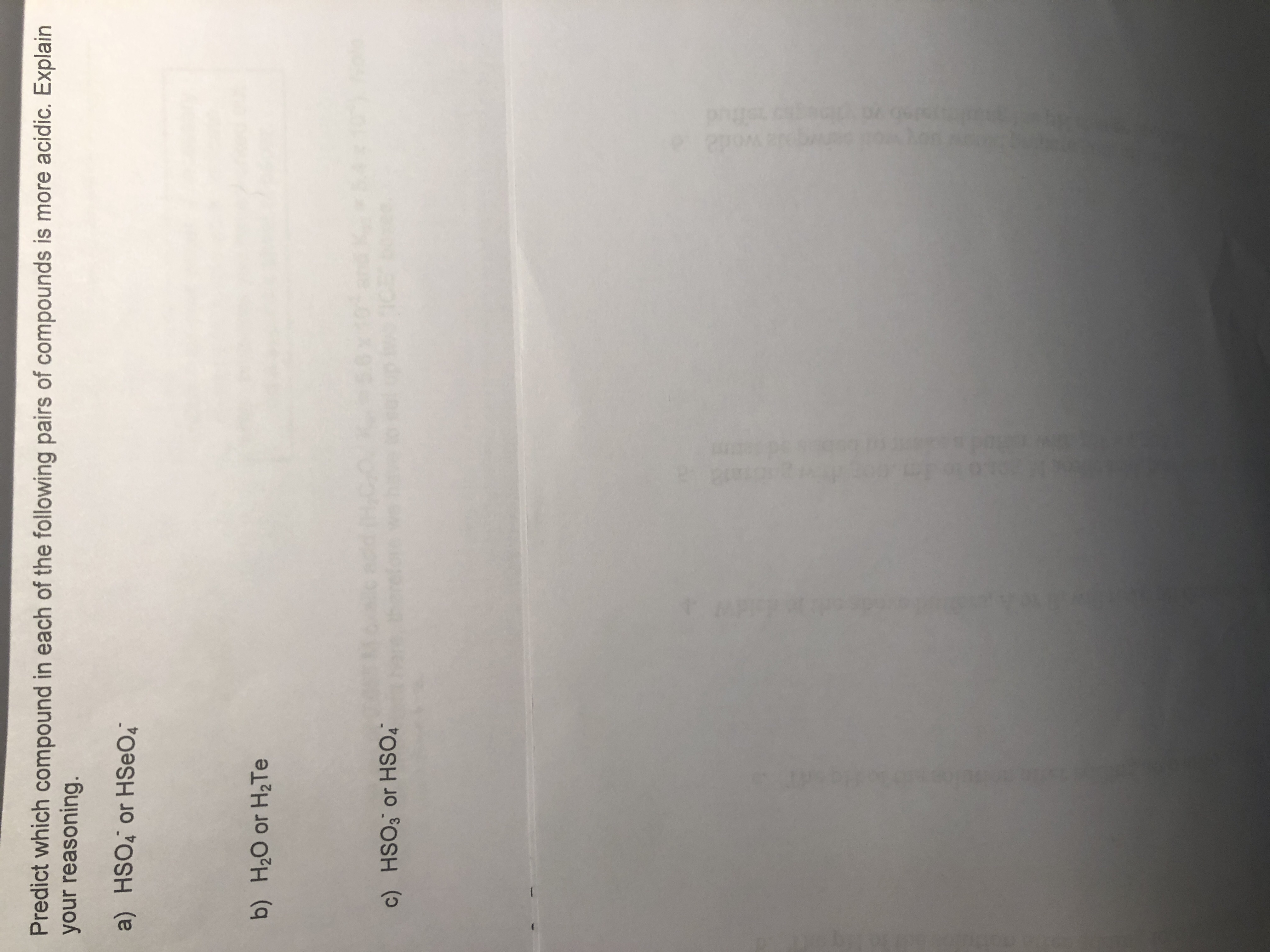
Chemistry
10th Edition
ISBN: 9781305957404
Author: Steven S. Zumdahl, Susan A. Zumdahl, Donald J. DeCoste
Publisher: Cengage Learning
expand_more
expand_more
format_list_bulleted
Question
thumb_up100%
Step by step

Transcribed Image Text:Predict which compound in each of the following pairs of compounds is more acidic. Explain
your reasoning.
a) HSO4 or HSeO4
b) H20 or H2Te
c) HSO3 or HSO4
Expert Solution
This question has been solved!
Explore an expertly crafted, step-by-step solution for a thorough understanding of key concepts.
This is a popular solution
Trending nowThis is a popular solution!
Step by stepSolved in 3 steps

Knowledge Booster
Learn more about
Need a deep-dive on the concept behind this application? Look no further. Learn more about this topic, chemistry and related others by exploring similar questions and additional content below.Similar questions
- 51. A concentrated perchloric acid solution is 65.8% HClO4 by mass and its density is 1.68 g mL−1. What volume (in litres) of the concentrated perchloric acid solution is needed to make 1.81 L of 2.62 mol L−1 HClO4(aq)?arrow_forwardHöhörs Chemistry- 4th Hour - Dr. Paul / Gases/Lesson 148 What does the kinetic molecular theory tell us about the temperature of a substance? O The temperature of a substance does not affect the motion of the particles. OA substance with a lower temperature has particles that move faster. O A substance with a higher temperature has particles that move slower. O A substance with a higher temperature has particles that move faster.arrow_forwardcan you help me with number 13 pleasearrow_forward
- A chemist prepares a solution of nickel(II) chloride NiCl2 by measuring out 97.μmol of nickel(II) chloride into a 150.mL volumetric flask and filling the flask to the mark with water. Calculate the concentration in mmol/L of the chemist's nickel(II) chloride solution. Round your answer to 2 significant digits.arrow_forwardCalculate the number of atoms in 264. µg of cadmium. Be sure your answer has the correct number of significant figures. Note: Reference the SI prefixes and Fundamental constants table for additional information. Cd atoms 0 x10 Xarrow_forwardTwo students were tasked to weigh 100 mg of sodium chloride (NaCI). Student A pressed the tare button after weighing the weighing paper and obtained the following data. What is the mass (g) of NaCl from Student A? Mass of weighing paper (g) 0.0011 Mass of weighing paper + NaCl (g) 0.1050 Mass of the NaCI (g) Your answer While Student B did not press the tare button after weighing the weighing paper and obtained the following data. What is the mass (g) of NaCl from Student B? * Mass of weighing paper (g) 0.0011 Mass of weighing paper + NaCI (g) 0.1010 Mass of the NaCI (g) Your answerarrow_forward
- You have a stock solution of HCI that is 37.4 % HCl by mass and has a density of 1.20 g/mL. What volume (in mL) of the concentrated HCI solution is needed to prepare 1.518 L of 0.693 M HCI? The molar mass of HCl is 36.458 g/mol. Report your answer to 1 decimal place.arrow_forward9.81m/s^2 to ft/s^2arrow_forwardor dividing measurements A chemistry student must write down in her lab notebook the concentration of a solution of sodium hydroxide. The concentration of a solution equals the mass of what's dissolved divided by the total volume of the solution. Here's how the student prepared the solution: • The label on the graduated cylinder says: empty weight: 5.250 g • She put some solid sodium hydroxide into the graduated cylinder and weighed it. With the sodium hydroxide added, the cylinder weighed 75.41 g. • She added water to the graduated cylinder and dissolved the sodium hydroxide completely. Then she read the total volume of the solution from the markings on the graduated cylinder. The total volume of the solution was 37.4 mL. What concentration should the student write down in her lab notebook? Be sure your answer has the correct number of significant digits. -1 Explanation Check 2021 McGraw-Hill Education All Rights Reserved Terms of Use Privacy Accessibility Thank The # $ % & 2 3arrow_forward
arrow_back_ios
arrow_forward_ios
Recommended textbooks for you
 ChemistryChemistryISBN:9781305957404Author:Steven S. Zumdahl, Susan A. Zumdahl, Donald J. DeCostePublisher:Cengage Learning
ChemistryChemistryISBN:9781305957404Author:Steven S. Zumdahl, Susan A. Zumdahl, Donald J. DeCostePublisher:Cengage Learning ChemistryChemistryISBN:9781259911156Author:Raymond Chang Dr., Jason Overby ProfessorPublisher:McGraw-Hill Education
ChemistryChemistryISBN:9781259911156Author:Raymond Chang Dr., Jason Overby ProfessorPublisher:McGraw-Hill Education Principles of Instrumental AnalysisChemistryISBN:9781305577213Author:Douglas A. Skoog, F. James Holler, Stanley R. CrouchPublisher:Cengage Learning
Principles of Instrumental AnalysisChemistryISBN:9781305577213Author:Douglas A. Skoog, F. James Holler, Stanley R. CrouchPublisher:Cengage Learning Organic ChemistryChemistryISBN:9780078021558Author:Janice Gorzynski Smith Dr.Publisher:McGraw-Hill Education
Organic ChemistryChemistryISBN:9780078021558Author:Janice Gorzynski Smith Dr.Publisher:McGraw-Hill Education Chemistry: Principles and ReactionsChemistryISBN:9781305079373Author:William L. Masterton, Cecile N. HurleyPublisher:Cengage Learning
Chemistry: Principles and ReactionsChemistryISBN:9781305079373Author:William L. Masterton, Cecile N. HurleyPublisher:Cengage Learning Elementary Principles of Chemical Processes, Bind...ChemistryISBN:9781118431221Author:Richard M. Felder, Ronald W. Rousseau, Lisa G. BullardPublisher:WILEY
Elementary Principles of Chemical Processes, Bind...ChemistryISBN:9781118431221Author:Richard M. Felder, Ronald W. Rousseau, Lisa G. BullardPublisher:WILEY

Chemistry
Chemistry
ISBN:9781305957404
Author:Steven S. Zumdahl, Susan A. Zumdahl, Donald J. DeCoste
Publisher:Cengage Learning

Chemistry
Chemistry
ISBN:9781259911156
Author:Raymond Chang Dr., Jason Overby Professor
Publisher:McGraw-Hill Education

Principles of Instrumental Analysis
Chemistry
ISBN:9781305577213
Author:Douglas A. Skoog, F. James Holler, Stanley R. Crouch
Publisher:Cengage Learning

Organic Chemistry
Chemistry
ISBN:9780078021558
Author:Janice Gorzynski Smith Dr.
Publisher:McGraw-Hill Education

Chemistry: Principles and Reactions
Chemistry
ISBN:9781305079373
Author:William L. Masterton, Cecile N. Hurley
Publisher:Cengage Learning

Elementary Principles of Chemical Processes, Bind...
Chemistry
ISBN:9781118431221
Author:Richard M. Felder, Ronald W. Rousseau, Lisa G. Bullard
Publisher:WILEY